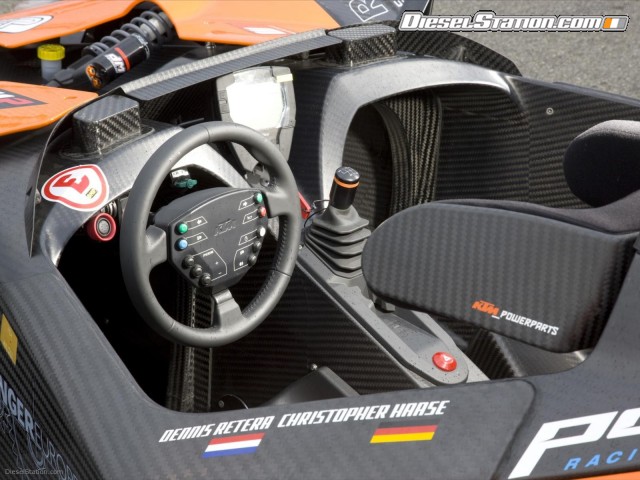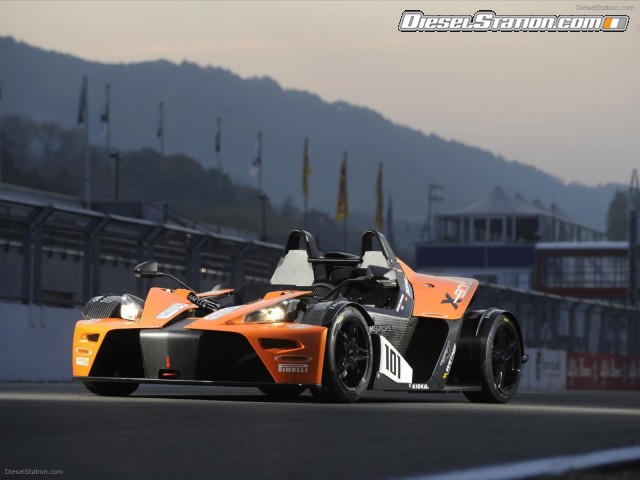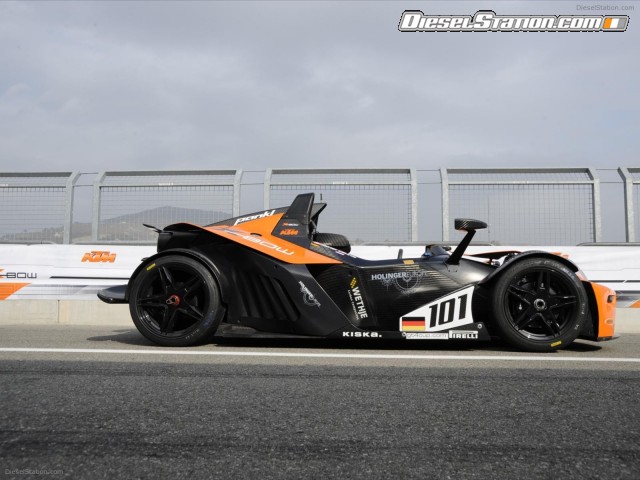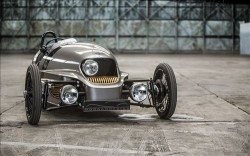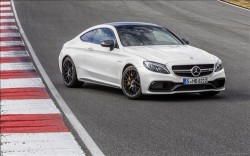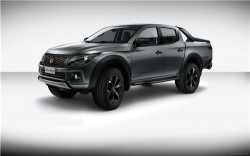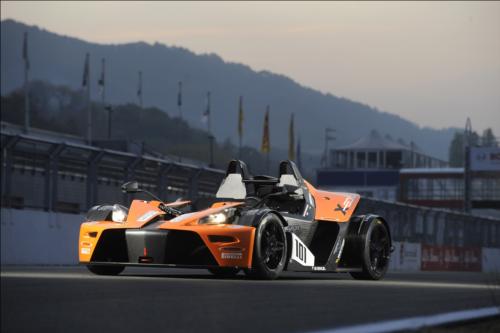KTM claims that the X-Bow, being a minimalist concept of the car, is extremely easy to maintain and offers significantly lower running costs than competitor cars and the typical cost of running a X-Bow in GT4 is just €3,000 per race, taking into account all ‘wear and tear’ parts, tyres and fuel. The KTM X-Bow race could sprint from 0-100 km/h in just 3.9 seconds and has a top speed of 137 mph(220 km/h). More details after the jump
KTM X-BOW ‘RACE’
KTM launches track-only version of its sensational X-Bow for customer racing in professional motorsport. The new KTM X-Bow 'Race' features 30 modified or new components.
1. KTM X-Bow: the concept and its realisation
2. ‘Ready to Race’: KTM X-Bow and its path to the racetrack
3. The first racing season: champions in GT4 Sports Light European Cup
4. GT racing for everyone: KTM Customer Racing Service
5. Racing throughout Europe: the Customer Racing Concept
6. Technical Data, Powertrains and more: the KTM X-Bow ‘Race’
1. KTM X-Bow: the concept and realisation
During the autumn of 2005, KTM CEO Stefan Pierer and Gerald Kiska, CEO and founder of the KISKA design studio, met for a routine meeting in Salzburg. The result was the beginnings of a visionary, seminal automobile project. Against the background of the worrying state of the European motorcycle market – fewer drivers held a motorcycle licence compared to earlier years – were the brightening prospects of a widening window of opportunity appearing in the market for ‘pure’ sportscars. Sportscars that, with a clear vision aligned to the KTM philosophy, ‘ready to race’, and clever engineering, might be able to deliver the excitement and immediacy of motorcycling – on four wheels rather than two.
The meeting was a success and the lightweight, high-performance KTM X-Bow was conceived. The ‘fathers’ of X-Bow moved quickly, commissioning an in-house ‘test mule’ to prove the validity of their concept and, in January 2006, began talking with Italian racing car- and sportscar specialist Dallara about the feasibility of KTM’s plan for developing such a road car. KTM celebrated the world premiere of its first-ever car at the Geneva Motor Show in 2007 when the X-Bow was officially born. The company sounded out the exclusive lightweight sportscar market with an aggressive design and a spectacular concept, complete with carbon fibre monocoque and the minimum of purist fittings.
Extensive market research was undertaken and, following an overwhelmingly positive response from sportscar enthusiasts and motoring media all around the world, the decision was made to go ahead with further development for the series production model of the KTM X-Bow. On the anniversary of that world premiere, KTM exhibited the production-ready version of the KTM X-Bow for the first time at the 2008 Geneva Motor Show. From this point on, progress was rapid. KTM had already started building a production plant in the Austrian ‘motor city’, Graz, and at the same time as the Automobile Salon in Geneva, assembly of the first prototype cars began. Series production started on 16 June, the first customer took delivery of his X-Bow on 5 August.
At the end of September 2008, the next milestone in KTM’s young car division was reached: the first KTM X-Bow ‘Race’, a fully FIA homologated GT4 Sports Light racing car, rolled off the assembly line in Graz. This new ‘Race’ model incorporates all the lessons learned during the X-Bow’s first season of professional motorsport in Europe. Compared to the standard road car, the X-Bow ‘Race’ features 30 modified or new components. The ‘Race’ model costs €82.900 ex-works and excluding national taxes – and customer deliveries are scheduled to begin in January 2009.
2. ‘Ready to Race’: the KTM X-Bow and its path to the racetrack
Motorsport is very important for KTM, as indicated by the company slogan ‘Ready to Race’. It was therefore entirely logical that at the same time as the plans for the series production were developing, KTM was planning to run the X-Bow competitively on the racetrack. Together with Dallara, KTM developed its own racing version, with the cars being run in the GT4 European Cup by German race team, Reiter Engineering. The decision by KTM to place the racing premiere of X-Bow in the hands of Reiter, rather than enter the championship with an in-house, factory-run operation, allowed KTM to use the GT4 entry as a pilot project to ‘power’ development of future customer motorsport applications as well as the production model.
As with the production road car, KTM drew on the vast expertise of world-renowned Italian racing driver Loris Bicocchi in the development of the X-Bow ‘Race’ car. He has been heavily involved in the X-Bow programme from the outset as test driver and played an important role in its chassis and dynamics tuning. Biccochi’s motorsport experience includes the testing, development and racing of many of the world’s most prestigious supercars – including the Koenigsegg CCR and the Bugatti Veyron.
Development timeline for the KTM X-Bow race car:
18.12.2007: Meeting KTM/Dallara/Reiter, decision made to build two GT4 cars
30.01.2008: First test at Misano (Italy) with a regular production X-Bow
18.02.2008: First test at Adria (Italy) with the GT4 series-mandatory semi-slick tyres
07.03.2008: Test at Adria (Italy) for defining the race chassis and suspension set-ups
13.03.2008: Official pre-season SRO-Test at Monza (Italy), presentation of final racing car
18.03.2008: FIA crash tests passed successfully
In retrospect, KTM can say that the X-Bow first saw the light of the day on a racetrack. Although conceived as road car, racing DNA is at its core and motorsport was a logical step. Together with the experienced Reiter Engineering GT team, KTM soon found the GT4 European Cup run by the SRO and Stephane Ratel as the ideal racing series for the X-Bow. Racing in the Sports Light category, KTM faced opponents from Lotus and Donkervoort, but the X-Bow also took on the immensely more powerful teams in the primary GT4 European Cup series, with their Aston Martin N24, BMW Z4 M, Ford Mustang or Nissan 350Z cars.
The changes made to the GT4 racing X-Bow (compared with the production model) are predominantly related to additional safety equipment demanded by the FIA regulations. The rollover bars are made of steel instead of aluminium; additional layers of zylon fibre are fastened to the flanks of the monocoque to enhance side-impact protection and prevent the penetration of sharp objects; the exhaust system has a racing cataytic converter; the mudguards are extended; and there is added side-impact protection between the front and rear wheels (to prevent tangling with other cars).
These modifications are so minor that they highlight the fundamentally sporting design of the X-Bow, confirming that even the road-going model has the soul of a racing car. In fact, the GT4 KTM X-Bow complies with the FIA crash-regulations (Article 258a) and meets the same safety standards as dedicated open wheel and ALMS-race cars.
Throughout 2008, competitive racing provided important feedback in the final phase of the series production car development. It also served as a trial run for the future ‘KTM Customer Racing Service’, and for the development of the customer racing version of the X-Bow.
3. The first racing season: champions in GT4 Sports Light European Cup
KTM had great expectations for the car’s first season and the private Reiter Engineering entry received significant assistance from KTM, with both companies keen to capture the inaugural Sports Light category championship. Despite the high hopes, the achievements of the car’s first season still came as a welcome surprise.
First year of racing for the KTM X-Bow:
31.03.2008: Comparison tests by the SRO at Nogaro (France)
19.04.2008: First official race entry in the ‘Tourist Trophy’ at Silverstone (England)
19.04.2008: First victory in the Sports Light category
20.04.2008: First top-five finish in overall result in the GT4
18.05.2008: First podium in overall result in the GT4
03.10.2008: First pole-position in the GT4
05.10.2008: Christopher Haase clinches the GT4 Sports Light European Cup title
05.10.2008: Three KTM drivers claim the first three places in the Sports Light class
After pre-season testing at Monza and Nogaro, a pair of X-Bows made a sensational competition debut at Silverstone (England) on 19 April 2008 – claiming 1st-2nd in-class finishes in both races and humbling many more powerful, more expensive GT4 machines.
The pair of X-Bows went on to repeat their 1st-2nd in-class form at Monza (Italy) and even claimed a remarkable third place overall in a 50-minute rain-soaked race. Only three race weekends later (Oschersleben, Spa-Francorchamps and Brno), KTM secured the title in the GT4 Sports Light category – with all three KTM drivers in the top three places overall.
And on the final racing weekend in Nogaro, providing a sensational climax to the season, Christopher Haase claimed the X-Bow’s first overall pole-position ahead of the more powerful GT4 racers. The young German driver then exploited his excellent qualifying performance to clinch overall victory in the GT4 Sports Light European Cup, ahead of team mates Dennis Retera and Catharina Felser.
4. GT racing for everyone: the KTM Customer Racing Service
Through its new Customer Racing Service, KTM aims to write a new chapter in national and international motor racing, by providing everything a racing enthusiast needs to take part in professional motorsport. ‘CRS’ customers from all over the world will be able to race their own X-Bow ‘Race’ in professional-level motorsport, with support from a dedicated team of KTM race technicians.
Whether competing in the GT4 European Cup, in the ADAC GT Masters or at selected 24 hour or endurance races around the globe, the KTM CRS will supply customers with a full support crew, an extensive range of spare parts, and technical support for all the drivers and teams who campaign a X-Bow.
Running a KTM X-Bow ‘Race’ is simple and cost effective. The minimalist concept of the car means that it is extremely easy to maintain and offers significantly lower running costs than competitor cars. Taking into account all ‘wear and tear’ parts, tyres and fuel, the typical cost of running a X-Bow in GT4 is just €3,000 per race.
As well as creating the CRS and working to make customer entry into GT racing even easier, KTM hopes to introduce a ‘Sports Light’ category in each country that hosts a national GT racing series. In addition, expansion to higher racing classes is planned – so that KTM customers are not only ‘Ready to Race’ immediately, in GT4, but also have the opportunity to achieve longer-term ambitions within a sustainable and progressive motorsport programme.
The CRS was designed with the idea of making entry to professional motorsport easy and affordable, with prices for one season’s GT4 racing only costing around €100,000 (based on four race cars minimum in one support structure). This figure is based on eight GT races – six in the GT4 European Cup and a further two in a national GT4 championship – and includes full service of a customer’s own car, transport, race service by specialist race engineers, hospitality for customers and team, spare parts (excluding crash-damaged parts), tyres, fuel, and driver and team wear.
5. Racing throughout Europe: the Customer Racing Concept
In 2009 KTM will launch the “KTM X-Bow Super Sport Cup” – a special league for all owners of a KTM X-Bow ‘Race’ operated through existing racing series. The new competition will fulfil the three main targets for KTM customer racing:
- Use of available racing infrastructure
- Racing series in a manageable radius (less than 800 km from KTM headquarters in Austria)
- Affordability
KTM will create two separate competitions: the KTM X-Bow Super Sport Cup North (which will include Germany, UK, Belgium and the Netherlands) and the KTM X-Bow Super Sport Cup South (which will include France, Spain and Italy). A maximum of two results from each country’s GT racing series will score points valid for the “X-Bow Super Sport Cup”. The eligible national race series are listed below:
KTM X-Bow Super Sport Cup North – eligible races:
- Germany: Oschersleben GT4 EC, GT Masters (4 races Super Sport)
- UK: Silverstone GT4 EC, GT4 & Super Sport national Championship, BRITT-Series
- Belgium: Spa-Francorchamps GT4 EC, GT4 24 hours of Zolder
- Netherlands: Dutch Supercar Challenge
KTM X-Bow Super Sport Cup South – eligible races:
- France: Nogaro GT4 EC, Endurance Race 3/6/12 hours
- Italy: Monza GT4 EC, GT Championship, 6 hours of Vallelunga
- Spain: GT4 tba, Tourismo Championship
The top 10 drivers from North and South competitions will compete in a final race at the end of the season for the title of "KTM X-Bow Super Sport Cup Champion".
KTM is very keen to expand the Customer Racing Concept to include other countries. This could include a KTM X-Bow customer cup ‘East’ (Czech Republic, Hungary, Slovakia) and a customer cup ‘Middle East’ (Dubai, Bahrain, Qatar).
6. Technical Data, PowerParts and more: the KTM X-Bow ‘Race’
Drawing on experience from KTM’s championship-winning first season of four-wheeled motorsport with the X-Bow, the new ‘Race’ model features 30 modified or new components – compared with the standard road car.
X-Bow ‘Race’ – changes at a glance:
1 Racing dampers
2 Racing brake pads
3 Racing catalytic converter
4 Semi-slick racing tyres (specified for GT4 EC racing)
5 Six-point racing harness
6 Extended side headrest: for greater driver head support
7 Kevlar-reinforced side panels
8 Carbon fibre windscreen extension: for telemetry equipment installation
9 Installation of front roll blocks (specified for GT4 EC racing)
10 Toughened rear roll hoops
11 Racing airbox design: lower than standard car design, for reduced drag
12 Extended rear bumper: to prevent tangling and minimise spray in wet track conditions
13 Side anti-tangle panel: to prevent inter-wheel tangling
14 Larger towing eye set
15 Fuel-spill seal: to prevent spilt fuel leaking onto engine with quick-fill system
16 Ballast installation plate (specified for GT4 EC racing)
17 Locked steering wheel (adjustable pre-race) in place of quick-adjustable system on standard car
18 Fire extinguisher system
19 Engine kill switch
20 Dry battery
21 Rain safety tail light
22 Revised rear bumper and rear crash box
23 Plastic headlight covers
24 Racing fuel system with quick-fill compatibility
25 Adjustable brake balance
26 Low profile racing windscreen
27 Handbrake removed
28 Front fins removed
29 Numberplate holder removed
30 Visible unpainted carbon body as standard
The KTM X-Bow ‘Race’ is also available with a variety of optional “PowerParts”:
1 Central locking wheels
2 Racing brake discs
3 Adjustable front anti-roll bar
4 Adjustable rear anti-roll bar
5 Adjustable front push rods
6 Airjack system (1x front, 2x rear) – parts
7 Airjack system – fitted
8 Easy-rescue driver seat shell
9 Racing mirrors with indicators or position lights
10 Kevlar-strengthened front panels
11 Carbon-fibre tonneau cover
12 2D data logging system with software
13 Display holder for 2D data logging system
14 Carbon revised rear bumper and rear crash box
15 Wider throttle pedal plate
Technical Data
| Bodystyle | Mid-engined two-seater open extreme sports car |
| Chassis | Carbon composite monocoque with transverse mid-mounted engine, rear-wheel drive and fully independent suspension |
| Structure | |
| Monocoque | Carbon composite construction |
| Torsional rigidity | 35000Nm per degree |
| Nosebox | Carbon construction |
| Rear subframe | Ultralight reinforced aluminium |
| Exterior panels | Carbon fibre |
| Underfloor | Ultra light carbon composite construction with rear diffuser |
| Engine | |
| Make | Audi TFSI |
| Type | Turbo-charged, 4-cylinder petrol with direct fuel injection |
| Capacity | 1984 cc / 2.0-litres |
| Bore & Stroke | 82.5 x 92.8 mm |
| Max power | 240 ps (177 kW) at 5500 rpm |
| Max torque | 310 Nm (229 lb ft) from 2000 to 5500 rpm |
| Valves | 16 (4 per cylinder) |
| Materials | Cast iron block, aluminium alloy cylinder head |
| Emissions class | Euro 4 compliant |
| Transmission | |
| Type | 6-speed manual |
| Suspension | |
| Front | Fully independent double wishbones with twin push-rod operated concentric coil spring/damper units (adjustable) mounted on top of the monocoque |
| Rear | Fully independent double wishbones with concentric coil spring/damper units (adjustable) Anti-roll bar |
| Brakes | |
| System | Hydraulic (unassisted) |
| Front | Brembo 305 mm ventilated discs with 4-piston fixed calipers |
| Rear | Brembo 262 mm ventilated solid discs with 2-piston fixed calipers |
| Wheels & Tyres | |
| Front | 17 x 7.5 inch alloys with 205/50 tyres |
| Rear | 18 x 9.5 inch alloys with 235/40 tyres |
| Performance | |
| Acceleration from standstill | |
| 0 to 50 mph | 2.86 sec [0 to 80 km/h] |
| 0 to 62 mph | 3.90 sec [0 to 100 km/h] |
| 0 to 75 mph | 5.27 sec [0 to 120 km/h] |
| 0 to 87 mph | 6.61 sec [0 to 140 km/h] |
| 0 to 99 mph | 8.51 sec [0 to 160 km/h] |
| Lateral Acceleration / Speed | |
| Racing: | 1.8 g max |
| Maximum speed | 137 mph [220 km/h] |
| Braking to standstill (warm brakes) | |
| 62 mph to 0 | 32.9 metres [100 to 0 km/h] |
| 99 mph to 0 | 77.9 metres [160 to 0 km/h] |
| Aerodynamic Performance | |
| Downforce | |
| At 62 mph | 48 kg [at 100 km/h] |
| At 124 mph | 193 kg [at 200 km/h] |
| Main dimensions | |
| Length | 3738 mm |
| Wheel base | 2430 mm |
| Width | 1900 mm |
| Dry weight | 825 kg |
| Height | 1205 mm |
Safety
FIA homologated Article 258A of Appendix J
Crash box: FIA Formula 3 crash test approved
Kevlar side intrusion protection panels
Extended side headrest
Fire extinguisher system
Dry battery with master switch
Front and rear towing eyes
Extended rear bumper including rear crash structure






